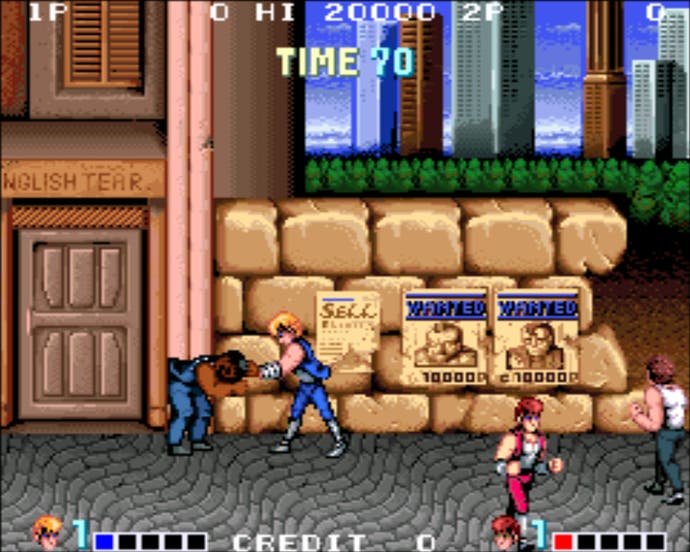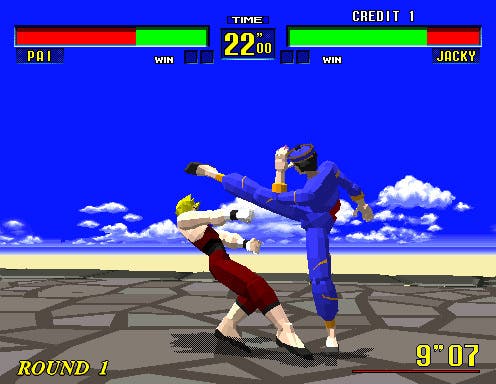The Tao of Beat-'em-ups
Part 2: A fight is not won by one punch or kick. Fighting from '85 to '93.
SEGA delivered the first genuine coin-op quality beat-'em-up to the Mega Drive with the sequel to the already awesome Streets of Rage - a follow-up that was so intensely playable (successfully designed to combat Nintendo's annex of the Final Fight licence) it was actually ported to the arcades.
The sheer weight of beat-'em-ups populating those arcades by the beginning of the '90s cannot be over-exaggerated. It pulsed with fighting thrills ranging from decent, yet mediocre titles like Altered Beast, Crude Busters, Street Smart and Bad Dudes vs Dragonninja (in the 80's, tough guys were born wearing shades, and calling someone a "bad dude" was the manliest of manly compliments), that served as acceptable pastimes while waiting for the awesome games like Final Fight, Shadow Warriors, Aliens Vs Predator and Golden Axe to be vacated. Which they never were.
Even traditionally disastrous TV and film licences looked toward the beat-'em-up for a suitable platform, and unexpected success stories blossomed from the usual manure pile of tie-in games. The Teenage Mutant Ninja Turtles, The Simpsons and even Michael Jackson's Moonwalker (which was right up kid's allies due to the singer's big release at the cinema) provided exhilarating fighting experiences.

Once again, as we consider the glut of games all vying for space in such a narrow genre, the potential for a popularity crash seemed imminent - the scrolling beat-'em-up was overdue for a catastrophe, and on the verge of being shunned by the inherently fickle gamer. But, just as Double Dragon had stepped in to rejuvenate the fighting game when it first threatened to wither, the lacklustre Street Fighter returned to catapult the arcades into an age of prosperity not seen since Pac-Man. A sub-genre that seemed to have burnt itself out only a couple of years ago was completely reinvigorated. The illustrious life of the fighting game once again deftly sidestepped market collapse and prolonged its own existence for one more round.
Fighting fans had almost forgotten about the tournament game - their attention focused intently on the scrolling beat-'em-up for nigh on five years - and its triumphant homecoming was like an old friend returning from war, a hero. Corner shops and laundrettes cleared space for Street Fighter II machines, and just as the scrolling beat-'em-up began its organic decline, the one-on-one returned for a second bout.
This time, technology wasn't an issue. It was a simple, aggressive battle to be the best, the bloodiest, the fastest, the biggest, the loudest, the hardest and the meanest. Pit Fighter might have tried it first, but Mortal Kombat captured the limitless bloodlust of the fighting fans unlike any other, while SNK's Neo Geo console used the tournament game to establish itself as the electronic authority on hand-to-hand, grudge match mêlée.
Just as suddenly, and without warning, it all ended. Some damn fool thought it'd be fun to release a 3D driving game, and stole the coins from the fighting game's boxes. Almost overnight, 2D was dead - beaten to an ironic pulp by the heavyweight 3D revolution.
"You must free your ambitious mind and learn the art of dying." - Bruce Lee

Steering wheels began to replace the joystick as the 3D uprising swept across the arcades like a plague of locusts - devouring the fertile, diverse landscape and replacing it with monolithic cabinets with little inside. The spectacle of graphically immersive driving games was, briefly, awe-inspiring, but the solemnity and sobriety of their gameplay couldn't follow the raw and unabashed adventure of a thousand different beat-'em-ups. It was (quite literally) a tough act to follow, and gamers began to drift away.
All was not lost, of course. Virtua Fighter began the story of the fighting game all over again - a solitary, sparse one-on-one tournament game attempting, successfully, to prove to the world that videogames were capable of recreating the human form on screen. But by 1993 the genre had matured significantly - it was a veteran of the industry it had supported through mediocrity and crisis; it's continued evolution was slower, more refined and contented to exist in the background.
There was never any reason to believe the golden age of fighting games would last forever. In many ways, a sudden death was fitting for the 2D beat-'em-up. It was an amazing time to be a blood-lusting, cavalier gamer, and there's no genre that doesn't owe some debt or other to the uncouth fighting game - the life-blood of an entire entertainment industry.
You can find part one of EG:Retro's history of beat-'em ups elsewhere on the site.







